Staged hypospadias repair for complex scrotal hypospadias in a 10-year-old boy
A 10-year male presented to Hypospadias Foundation Clinic with complaints of passing urine from the scrotal region. As a result, he had to sit and pass urine even at this age. He also had a congenital heart defect (Atrial septal defect) for which he had undergone surgery at 4 years of age and had recovered well. Since he had associated cardiac defect, parents decided to get the hypospadias surgery later hence the late presentation of hypospadias.
On examination in the OPD, the meatus was in the scrotal region and there was downward curvature of the penis. Also, the right testis was undescended, not palpable in the scrotum but was palpable in the inguinal region. The size of the penis was measured and was found to be normal for age i.e Stretched penile length- 33mm and Glans diameter was 16mm. Karyotyping was done in view of hypospadias associated with undescended testis and was noted to be normal male karyotype (46XY). Parents were counselled for two stage hypospadias surgery in view of scrotal hypospadias with significant chordee.
Surgery was started by taking stay stitch on the glans with 4-0 prolene and complete degloving was done. Deep degloving was done which is till the scrotal pad of fat on the ventral side and till the suspensory ligament on the dorsal side. After complete degloving, artificial erection test was done to assess the degree of chordee. Chordee was more than 90 degrees. Spongiosum was mobilized on either side and urethral plate was divided. Proximal urethra was mobilized till the scrotal region. Dysplastic tissues on the ventral side were removed and chordee reassessed. Persistent chordee of more than 60 degree was noted. Ventral corporotomies were done by placing 3 horizontal incisions on the ventral side with the middle incision at the site of maximum curvature. Even after corporotomies, the chordee was significant. Hence, we planned to proceed with ventral lengthening procedure called as dermal graft. Deep corporotomy was given at the site of maximum curvature which is the site of middle corporotomy. This was a transverse incision made from 3’o clock to 9’o clock position preserving the erectile tissue. Dermal graft was harvested from the left inguinal region. Elliptical incision was given in the left inguinal region at the lowest skin crease. Defatting and de-epithelization of the graft was done. Dermal graft was then sutured at the site of tunical defect with 6-0 PDS interrupted sutures. Chordee was assessed after dermal graft placement and no chordee noted.
Once the chordee was completely corrected, the proximal urethra was sutured at the proximal penile region. Glans wings were raised. Byars flaps were created by dividing the dorsal prepuce in the midline and rotating it to the underside of the penis and sutured from the glans till around the meatus at the penoscrotal region. Right undescended testis was brought to normal scrotal location completing the orchidopexy at the end of the surgery hence completing both orchidopexy and stage 1 hypospadias repair (chordee correction and byars flaps).
Second stage hypospadias repair:
After 6 months of stage 1 chordee correction, the child underwent second stage urethroplasty. Artificial erection test was done at the start of the procedure to assess the presence of any residual chordee. No residual chordee was seen. The prepucial flaps which were done in stage 1 had healed well. The flaps were wide and supple with good blood supply. 15mm wide marking of the flaps were done, local anaesthesia infiltrated at the marked site and incision given. Incisions were deepened till the corpora. Excess skin on either side was trimmed. Urethroplasty was done over 7Fr catheter in 2 layers with 5-0 vicryl. Glans wings were raised. Dartos flap was raised from both sides and sutured over the urethroplasty. Glansplasty was done. A new meatus was created on the glans. Post operative period, dressing was changed on post operative day 7. Catheter was removed on post operative day 10. He was passing urine in single straight stream without pain after catheter removal. Parents were very happy with the outcome and boy was overjoyed to stand and pass urine in a single straight stream.
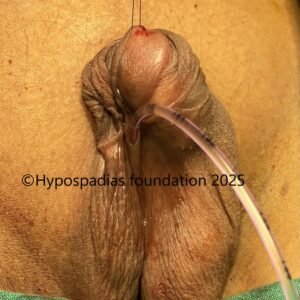
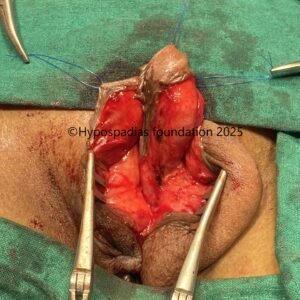
Pic 1: On clinical examination- scrotal hypospadias with severe chordee. Surgery was started by complete degloving.
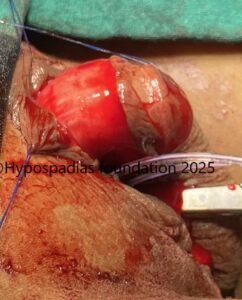
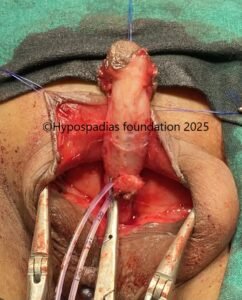
Pic 2: Artificial erection test showed chordee of more than 90 degrees. Urethral plate was divided.

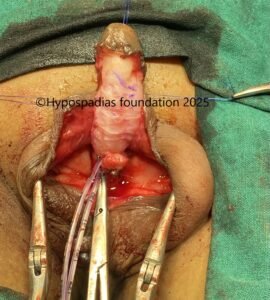
Pic 3: Artificial erection test after urethral plate division showed chordee of more than 60 degrees, hence three ventral corporotomies given.

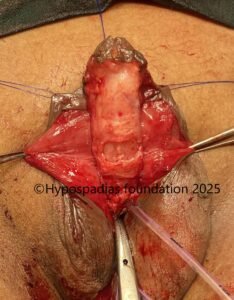
Pic 4: Persistent chordee of more than 30 degrees noted even after corporotomies. Hence, we decided to proceed with ventral lengthening procedure called as dermal graft
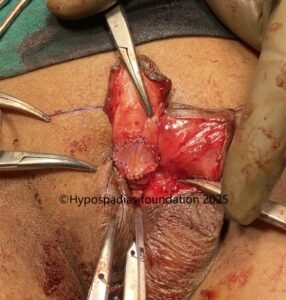
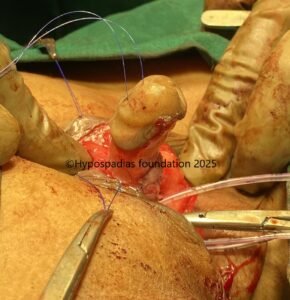
Pic 5: Dermal graft placed at the site of deep corporotomy. Post dermal graft, complete straightening of the penis was achieved
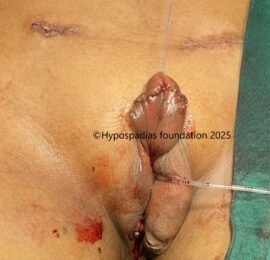
Pic 6: Completion of stage 1 chordee correction and right orchidopexy
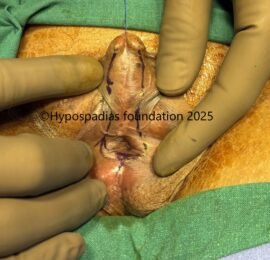
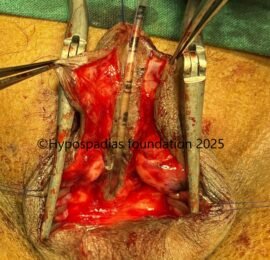
Pic 7: 15mm wide marking of the flaps done. Incision given at the site of marking and deepened till the tunica albuginea
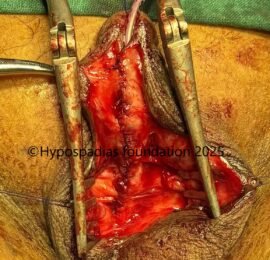

Pic 8: First layer of urethroplasty done in continuous subcuticular fashion. Dartos flap raised on both sides to suture over the urethroplasty.
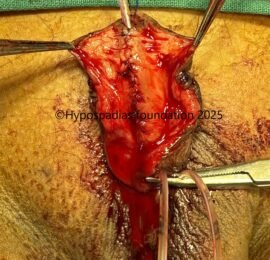
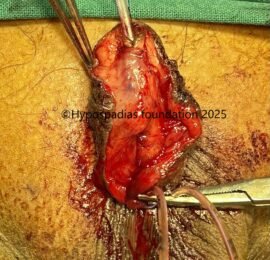
Pic 9: Glans wings were raised, distal urethroplasty done and dartos flap sutured over the urethroplasty
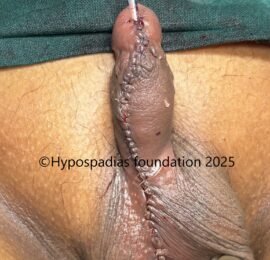
Pic 10: Completion of stage 2 urethroplasty.


Pic 11: Cosmetic result 6 months after surgery and passing urine in single straight stream
Complex scrotal hypospadias repair in a boy
Complex hypospadias repair refers to the surgical correction of severe form of hypospadias where the opening of the urethra is located way down from the glans mostly at the penoscrotal junction, scrotal or at the perineal region and is associated with severe downward curvature of the penis. In the above case along with complex hypospadias the boy also had undescended testis. While ideally surgery should have been done before 4-5 years of age, here the parents brought him to us late. This was because in this child there was an associated cardiac defect and cardiac defect repair is more important than the hypospadias correction. Hence, the ideal age of performing surgery before 18 months of age or maximum by 5 years of age is possible only for those kids who are born at term with normal weight gain and have no other associated life-threatening conditions.
The hypospadias repair in complex hypospadias usually is done in 2 stages. In first stage, complete straightening of the penis is done, and foreskin is rearranged followed by urethroplasty in second stage which is done 6-8 months after stage 1.
The emphasis here is on never rushing to perform hypospadias surgery in one stage. The primary repair is crucial for the following reasons:
- Tissue quality in primary non operated hypospadias: The first surgery is performed on virgin tissue which has no scarring and is not altered by previous procedures. Using well vascularized tissues will significantly increase the chance of successful outcomes of surgery.
- Increased complexity during reoperation: Redo surgeries are always more challenging than primary surgery. Scar tissue, poor blood supply and lack of native tissues made each redo surgery difficult further increasing the risk of complications.
- Minimizing: Lesser number of surgeries will reduce the risk of overall anaesthesia and surgical trauma.
Complications can occur even after primary repair, but the goal is to decrease these risks. The best chance of successful outcome after first surgery is when it is well-planned and skilfully executed by an expert pediatric urologist or a hypospadias surgeon.
About Hypospadias Foundation
At hypospadias foundation, every year we treat more than 250 children and adults with hypospadias. Children and adults from more than 25 countries visit our hypospadias foundation center in search of cure for hypospadias. Very few centers all over the world have achieved excellence in hypospadias and we are one among them. We are dedicated in treating hypospadias and want to help kids and children suffering from hypospadias.
Dr. A.K. Singal is a renowned and top hypospadias surgeon practicing in Navi Mumbai. Dr. Singal’s passion and expertise in Hypospadias led him to establish the hypospadias foundation in 2006. The Hypospadias Foundation is the World’s First and India’s only hospital dedicated to caring for children and adults with hypospadias. It is considered as the best hospital for hypospadias surgery in India. Dr Ashwitha Shenoy is a trained pediatric surgeon and hypospadias expert and Dr Shenoy and Dr Singal work together as a team.
Dr Shenoy along with Dr Singal aim to provide world class surgery and treatment for children and adults with hypospadias and DSD.
